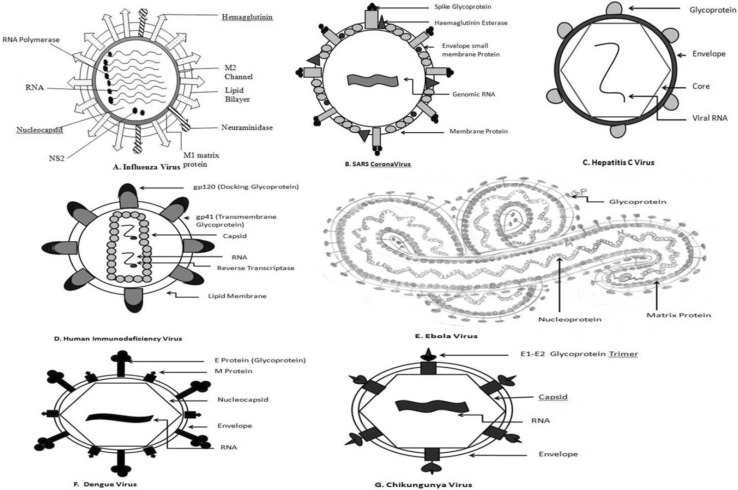Diagnosis and Treatment of Viral Infection
Glycosylation modifications have been demonstrated to be involved in virus infection and the immunity of host cells. As one of the major components of human pathogenic viruses, viral glycoproteins play increasingly important roles in the development of novel diagnostics. Here, we focus on the importance of viral glycoproteins in health and disease, especially their potential roles in the development of novel diagnostics.
Viral diagnostic tests
 At present, viral diagnostic tests can be broadly classified into three categories in general, including direct detection, indirect examination (virus isolation), and diagnosis by serology. In the first test, the clinical sample is examined directly to identify any presence of virus particles, virus antigen, or viral nucleic acids, which can be achieved by electron microscopy and molecular biological techniques (such as PCR/RTPCR). These techniques are useful, however, they are technically demanding and costly. In case of indirect detection by virus isolation, the sample has to be added into eggs, animals, or cell culture to grow the virus in vitro. These tests usually take a long time and are susceptible to environmental factors. Serology usually constitutes the bulk of the work of any virology laboratory, and is the mainstream of viral diagnosis. The determination of structural viral glycoproteins or early glycoprotein antigen formation in host cells due to viral infection is an emerging discipline in viral immunodiagnostics. The pathogenic glycans either virus-encoded or host-derived often induce high humoral responses in the human body, resulting in virus-specific high levels of glycan-specific antibodies. This is the basis of developing novel diagnostic assays. The method is usually high specificity and sensitivity.
At present, viral diagnostic tests can be broadly classified into three categories in general, including direct detection, indirect examination (virus isolation), and diagnosis by serology. In the first test, the clinical sample is examined directly to identify any presence of virus particles, virus antigen, or viral nucleic acids, which can be achieved by electron microscopy and molecular biological techniques (such as PCR/RTPCR). These techniques are useful, however, they are technically demanding and costly. In case of indirect detection by virus isolation, the sample has to be added into eggs, animals, or cell culture to grow the virus in vitro. These tests usually take a long time and are susceptible to environmental factors. Serology usually constitutes the bulk of the work of any virology laboratory, and is the mainstream of viral diagnosis. The determination of structural viral glycoproteins or early glycoprotein antigen formation in host cells due to viral infection is an emerging discipline in viral immunodiagnostics. The pathogenic glycans either virus-encoded or host-derived often induce high humoral responses in the human body, resulting in virus-specific high levels of glycan-specific antibodies. This is the basis of developing novel diagnostic assays. The method is usually high specificity and sensitivity.
Application of viral glycoproteins in diagnostics
Since glycans are major components of the outermost surface of viruses, the pattern of glycans and glycan-binding receptors has a influence on most interactions between the viral pathogens with their hosts. So far, a variety of glycoproteins have been identified in viral pathogens.
 Fig1. Distribution of Glycoproteins on the surfaces of different viruses a influenza virus, b SARS Coronavirus, c Hepatitis C virus, d human immunodeficiency virus, e Ebola virus, f Dengue virus and g Chikungunya virus. (Banerjee, N., & Mukhopadhyay, S., 2016)
Fig1. Distribution of Glycoproteins on the surfaces of different viruses a influenza virus, b SARS Coronavirus, c Hepatitis C virus, d human immunodeficiency virus, e Ebola virus, f Dengue virus and g Chikungunya virus. (Banerjee, N., & Mukhopadhyay, S., 2016)
Human immunodeficiency viruses (HIV)
Three glycoproteins have been identified in HIV, including glycoprotein (gp) 120, gp 160 and gp 41, all encoded by the ENV gene. It is reported that antibodies against final ENV proteins gp 120 and gp 41 as well as precursor gp160 ENV protein can detect all clinical stages of HIV. And the sensitivity and specificity of currently available diagnostic system is relatively high, a sensitivity of 95%-97% at 7-93 days and a specificity of 95 %.
Dengue (DENV)
NS1 is a highly conserved glycoprotein of DENV and can be expressed as both secreted and membrane-associated forms. Since secreted NS1 has a high level during the early stages of the disease (from 1 day after the onset of symptoms up to early convalescences). Circulating dengue NS1 in sera can be detected using ELISA assay or lateral flow-based RDTs, providing an alternative to indirect examination or PCR for early dengue diagnosis.
Chikungunya virus (CHIKV)
There are two envelope glycoproteins in CHIKV, namely E1 and E2 glycoprotein. The sensitivity of recombinant CHIKV E1 and E2 glycoprotein-based ELISA was reported at 77.5 and 90 % respectively. The specificity for both cases was 100 %. The data highlights the potential for these two glycoproteins in the CHIKV diagnosis.
For advance diagnosis of infectious diseases, it is necessary to develop available biomarkers. As human mobilization increases, the rapid spread of infectious agents requires more rapid diagnostic systems. And high titers of antibodies against the antigenic viral glycoproteins have paved the way for novel diagnostic applications. Creative Proteomics is an contract research organization (CRO) providing a series of viral glycoproteomics services. We are dedicated to providing a range of services tailored to meet our customers' needs. Feel free to contact us with your inquiries about viral glycoproteomics.
Related services
Reference
- Banerjee, N., & Mukhopadhyay, S. (2016). “Viral glycoproteins: biological role and application in diagnosis.” Virusdisease, 27(1), 1-11.
* For research use only.

 At present, viral diagnostic tests can be broadly classified into three categories in general, including direct detection, indirect examination (virus isolation), and diagnosis by serology. In the first test, the clinical sample is examined directly to identify any presence of virus particles, virus antigen, or viral nucleic acids, which can be achieved by electron microscopy and molecular biological techniques (such as PCR/RTPCR). These techniques are useful, however, they are technically demanding and costly. In case of indirect detection by virus isolation, the sample has to be added into eggs, animals, or cell culture to grow the virus in vitro. These tests usually take a long time and are susceptible to environmental factors. Serology usually constitutes the bulk of the work of any virology laboratory, and is the mainstream of viral diagnosis. The determination of structural viral glycoproteins or early glycoprotein antigen formation in host cells due to viral infection is an emerging discipline in viral immunodiagnostics. The pathogenic glycans either virus-encoded or host-derived often induce high humoral responses in the human body, resulting in virus-specific high levels of glycan-specific antibodies. This is the basis of developing novel diagnostic assays. The method is usually high specificity and sensitivity.
At present, viral diagnostic tests can be broadly classified into three categories in general, including direct detection, indirect examination (virus isolation), and diagnosis by serology. In the first test, the clinical sample is examined directly to identify any presence of virus particles, virus antigen, or viral nucleic acids, which can be achieved by electron microscopy and molecular biological techniques (such as PCR/RTPCR). These techniques are useful, however, they are technically demanding and costly. In case of indirect detection by virus isolation, the sample has to be added into eggs, animals, or cell culture to grow the virus in vitro. These tests usually take a long time and are susceptible to environmental factors. Serology usually constitutes the bulk of the work of any virology laboratory, and is the mainstream of viral diagnosis. The determination of structural viral glycoproteins or early glycoprotein antigen formation in host cells due to viral infection is an emerging discipline in viral immunodiagnostics. The pathogenic glycans either virus-encoded or host-derived often induce high humoral responses in the human body, resulting in virus-specific high levels of glycan-specific antibodies. This is the basis of developing novel diagnostic assays. The method is usually high specificity and sensitivity.  Fig1. Distribution of Glycoproteins on the surfaces of different viruses a influenza virus, b SARS Coronavirus, c Hepatitis C virus, d human immunodeficiency virus, e Ebola virus, f Dengue virus and g Chikungunya virus. (Banerjee, N., & Mukhopadhyay, S., 2016)
Fig1. Distribution of Glycoproteins on the surfaces of different viruses a influenza virus, b SARS Coronavirus, c Hepatitis C virus, d human immunodeficiency virus, e Ebola virus, f Dengue virus and g Chikungunya virus. (Banerjee, N., & Mukhopadhyay, S., 2016)